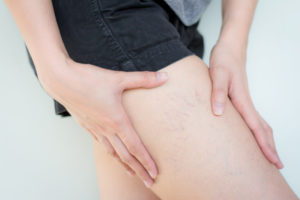Are you worried about vein reflux? Well, if so, the science just may be on your side. But before we can explain why, here's a quick definition of venous refux.
Vein reflux is a symptom of vein disease. You see, when the veins in your leg are healthy, the valves in them allow blood to flow up to your heart, fighting gravity. But when you have vein disease, those valves can't work properly, and that allows blood to flow back down your legs instead, which is what we call venous reflux. Depending on how long it's left untreated, vein reflux can leave you with varicose veins, as well as painful, swollen or achy legs. You may experience cramping, itchiness and a heavy feeling or tired legs. The skin on your legs can change or lose colors, or you can even develop venous ulcers. Now, all of these symptoms won't develop at once. In fact, if you act quickly, you can prevent or reverse many side effects of reflux. Here's the story:3
When your circulatory system works properly, your veins bring blood back up to your heart from your lower extremities. Along the way, little flaps (called valves) help the blood flow against gravity. (They do so by closing up as the blood travels past them.) But sometimes, those valves stop doing their jobs well. And that's when venous reflux can set in. Because some of the blood that's supposed to travel up and away from your legs gets stuck, pooling in your veins while they darken, stretch and bulge. 
At that stage of reflux, you may start to notice visible symptoms, like varicose veins. For many people, varicose veins are just a cosmetic concern. But in reality, these unsightly veins can cause serious medical problems. And the study we'll review shows how important it is to treat even minor cases of venous reflux.
The purpose of the study was to explore the effectiveness of different treatment methods for ulcers (hard to heal wounds that often develop on the legs of people with insufficient blood flow in their legs.)
Study author Aleksandra Jaworucka-Kaczorowska discovered that 85% of the ulcer patients she met with also had superficial venous reflux. Furthermore, she found that by treating their reflux with sclerotherapy, a treatment we offer in our Houston and Dallas area vein clinics, patients' venous reflux vastly improved and their ulcers healed at a faster rate!
Sclerotherapy is a great treatment option for veins that don't show signs of serious vein disease.

During the procedure, we will inject a solution into your affected vein, making it shrink and close so that blood flow will be redirected through your other, healthier veins. After this process, your vein will eventually shrink and disappear from view on the surface of your skin.
Before performing sclerotherapy, your vein doctor will conduct a thorough examination and review your history to make sure that your vein issue isn't a sign of a more serious underlying health issue. But if you are a good candidate for sclerotherapy, it is a fast, minimally invasive treatment that requires no sedation or anesthesia. Most patients can return to work or other activities quickly. It may require more than one session to completely treat your spider veins. But since you'll enjoy a cosmetic benefit and contribute to the fight against leg ulcers, it's a treatment option that is certainly worth considering!
Are you ready to deal with minor or major vein problems? We're here to help you achieve your cosmetic and improved health goals. Simply schedule a consultation with our experts. We can perform diagnostic tests and make suggestions for your best treatment options.
Source Page: https://texaseva.com/sources/

Scheduling
Please contact our dedicated specialists to schedule a consultation today.
2025 Texas Endovascular. All rights reserved. Website Design by Healthcare Success